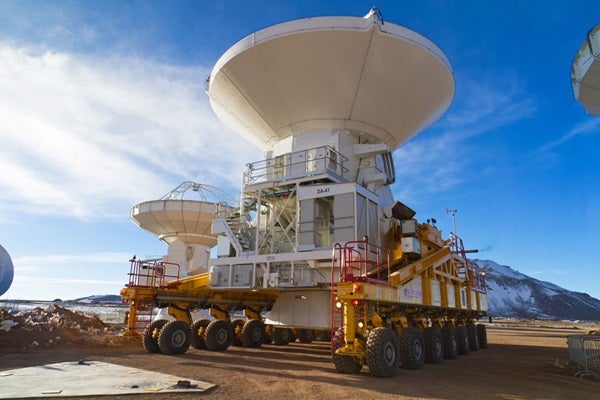Although 16 sounds like just another number, it is the number of antennas specified for ALMA to begin its first science observations, and is therefore an important milestone for the project. Soon, astronomers will begin conducting new scientific research with ALMA.
The antenna, manufactured by the European AEM Consortium under contract from the European Southern Observatory (ESO), was handed over to the observatory in April at the Operations Support Facility (OSF), after 6 months of testing. The OSF is at an altitude of 9,500 feet (2,900m) in the foothills of the Chilean Andes. There, it was equipped with highly sensitive detectors, which were cooled by liquid helium, and other necessary electronics. Now, one of the giant ALMA transporter vehicles has taken it 17 miles (28 kilometers) farther, along the dry desert road to the AOS. The AOS is the last port of call in a long journey that began when the component parts of the antenna were manufactured in factories across Europe.
“It’s great to see the first European ALMA antenna reach Chajnantor,” said Stefano Stanghellini from ESO. “It is from this arid plateau that these masterpieces of technology will be used to study the cosmos.”
ALMA’s Early Science observations are planned to begin later this year. Although ALMA will still be under construction, the 16-antenna array that will be available already outmatches all other telescopes of this kind. Astronomers from around the world have submitted almost 1,000 proposals for Early Science observations. This level of demand is about 9 times the number of observations that are expected to be carried out during the first phase of Early Science, which demonstrates how excited researchers are to use ALMA, even at this early stage.
The final step from the OSF to the Chajnantor plateau is a relatively short journey, but for ALMA it makes a great difference. The plateau’s elevated location — 6,900 feet (2,100m) higher than the OSF — gives it the dry conditions that are vital for observing at millimeter and submillimeter wavelengths, as these faint signals from space are easily absorbed by Earth’s atmosphere.
While Chajnantor is perfect for ALMA, the high altitude and lack of oxygen make it less pleasant for the site’s human visitors.
Although there is a Technical Building on Chajnantor — it is in fact one of the highest buildings in the world — the people working on ALMA do as much as possible from the lower altitude of the OSF, operating the telescope remotely.
When construction is completed in 2013, ALMA will have a total of 66 state-of-the-art antennas, which will work together as a single powerful telescope observing millimeter- and submillimeter-wavelength light. ALMA will help astronomers study the origins of planets, stars, galaxies, and even the universe itself by observing cool molecular gas and dust in the Milky Way and beyond, as well as the relic radiation left over from the Big Bang.
Although 16 sounds like just another number, it is the number of antennas specified for ALMA to begin its first science observations, and is therefore an important milestone for the project. Soon, astronomers will begin conducting new scientific research with ALMA.
The antenna, manufactured by the European AEM Consortium under contract from the European Southern Observatory (ESO), was handed over to the observatory in April at the Operations Support Facility (OSF), after 6 months of testing. The OSF is at an altitude of 9,500 feet (2,900m) in the foothills of the Chilean Andes. There, it was equipped with highly sensitive detectors, which were cooled by liquid helium, and other necessary electronics. Now, one of the giant ALMA transporter vehicles has taken it 17 miles (28 kilometers) farther, along the dry desert road to the AOS. The AOS is the last port of call in a long journey that began when the component parts of the antenna were manufactured in factories across Europe.
“It’s great to see the first European ALMA antenna reach Chajnantor,” said Stefano Stanghellini from ESO. “It is from this arid plateau that these masterpieces of technology will be used to study the cosmos.”
ALMA’s Early Science observations are planned to begin later this year. Although ALMA will still be under construction, the 16-antenna array that will be available already outmatches all other telescopes of this kind. Astronomers from around the world have submitted almost 1,000 proposals for Early Science observations. This level of demand is about 9 times the number of observations that are expected to be carried out during the first phase of Early Science, which demonstrates how excited researchers are to use ALMA, even at this early stage.
The final step from the OSF to the Chajnantor plateau is a relatively short journey, but for ALMA it makes a great difference. The plateau’s elevated location — 6,900 feet (2,100m) higher than the OSF — gives it the dry conditions that are vital for observing at millimeter and submillimeter wavelengths, as these faint signals from space are easily absorbed by Earth’s atmosphere.
While Chajnantor is perfect for ALMA, the high altitude and lack of oxygen make it less pleasant for the site’s human visitors.
Although there is a Technical Building on Chajnantor — it is in fact one of the highest buildings in the world — the people working on ALMA do as much as possible from the lower altitude of the OSF, operating the telescope remotely.
When construction is completed in 2013, ALMA will have a total of 66 state-of-the-art antennas, which will work together as a single powerful telescope observing millimeter- and submillimeter-wavelength light. ALMA will help astronomers study the origins of planets, stars, galaxies, and even the universe itself by observing cool molecular gas and dust in the Milky Way and beyond, as well as the relic radiation left over from the Big Bang.










